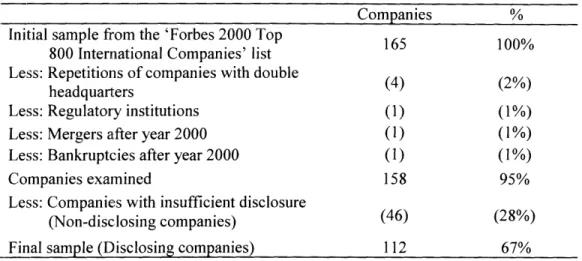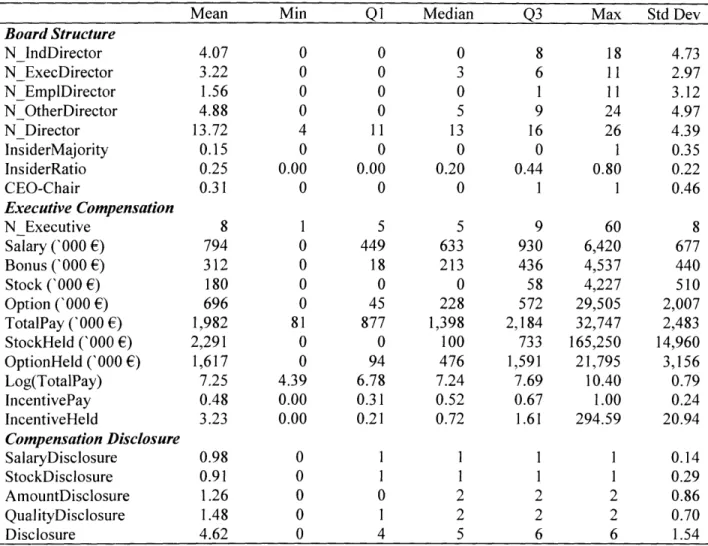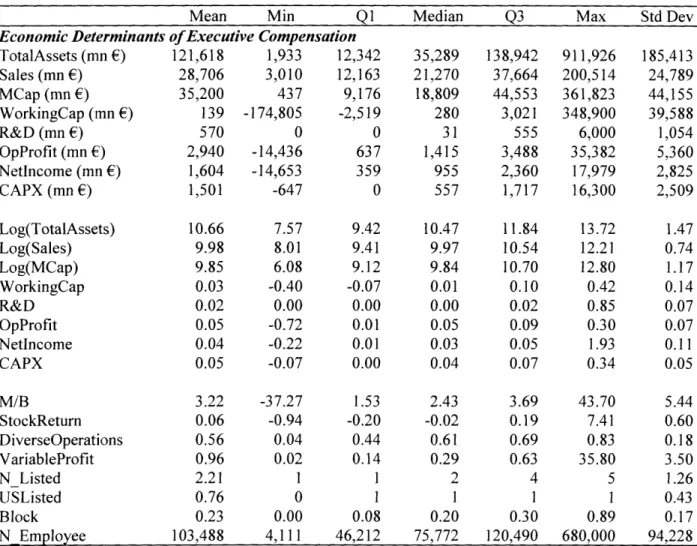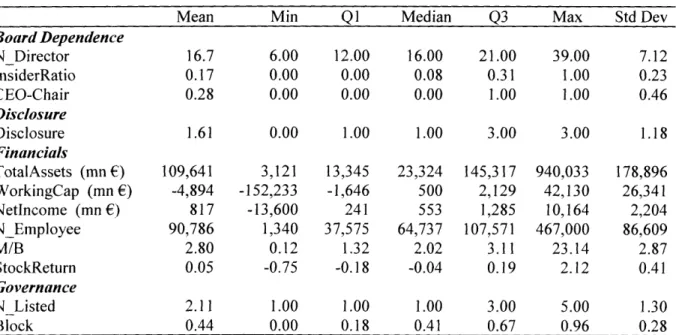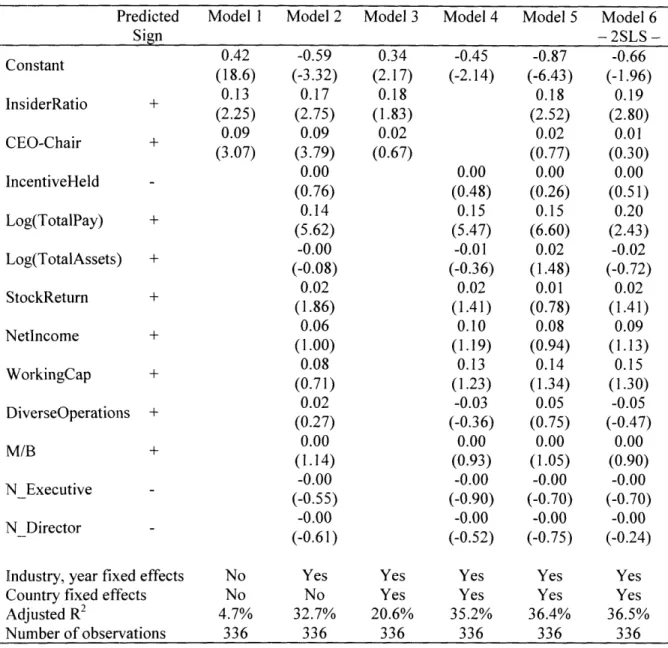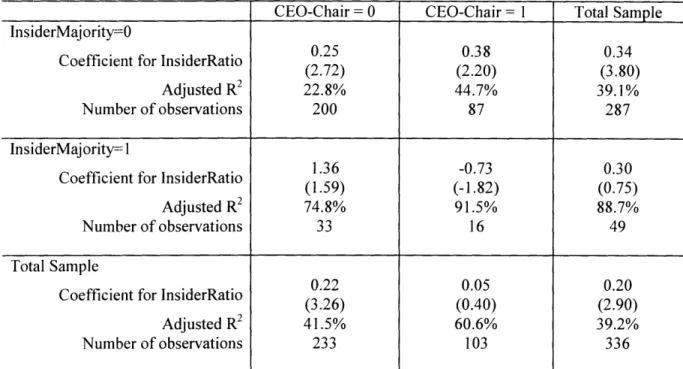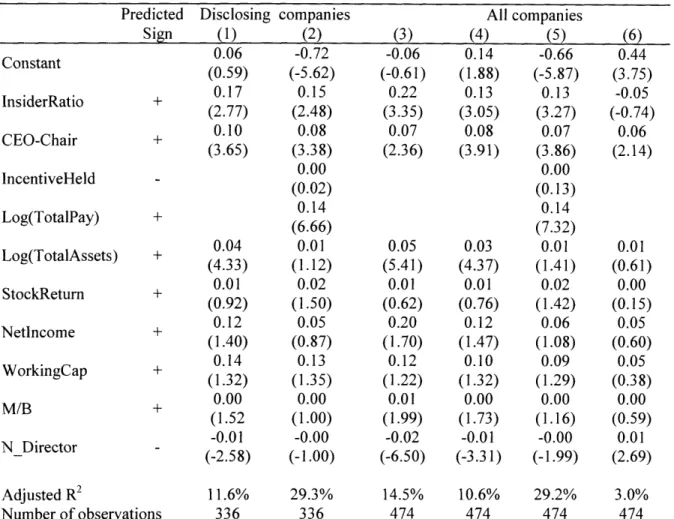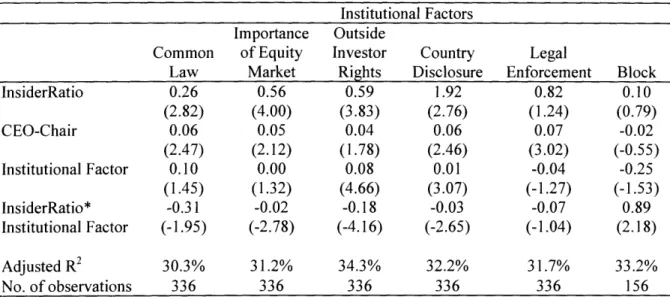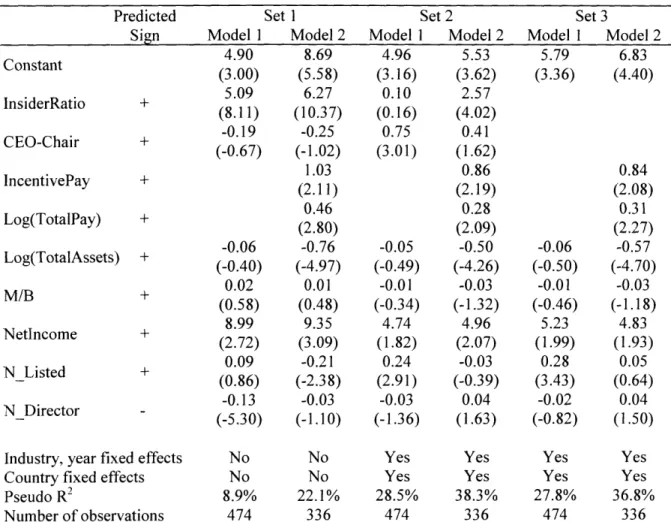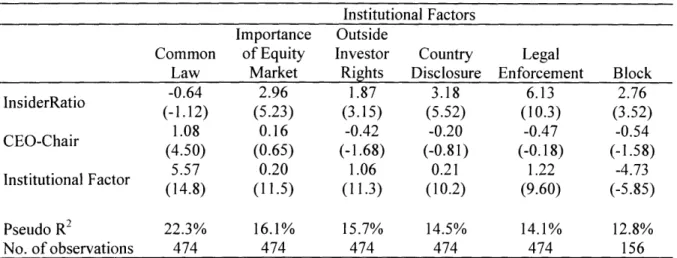Effect of Board Independence on Incentive Compensation and
Compensation Disclosure: Evidence from Europe
By Volkan Muslu
B.S. Electrical and Electronics Engineering Bilkent University, Ankara 1996
M.B.A.
Ko9 University, Istanbul 1998
SUBMITTED TO THE SLOAN SCHOOL OF MANAGEMENT IN PARTIAL FULFILLMENT OF THE REQUIREMENTS
FOR THE DEGREE OF
DOCTOR OF PHILOSOPHY IN MANAGEMENT AT THE
MASSACHUSETTS INSTITUTE OF TECHNOLOGY SEPTEMBER 2005
© 2005 Volkan Muslu. All rights reserved.
The author hereby grants to MIT permission to reproduce and to distribute publicly paper and electronic copies of this thesis document in whole or in part.
ArT
Signature of Author: , '["Sloan School of Management
June 10, 2005
c
Certified by:
-S.P. Kothari Gordon Y Billard Professor of Accounting
Thesis Supervisor Accepted by: ,
Birger Wernerfelt J.C. Penney Professor of Management Science; Chair MASSACHUSETTS INS IE
OF TECHNOLOGY
Effect of Board Independence on Incentive Compensation and
Compensation Disclosure: Evidence from Europe
By Volkan Muslu
Submitted to the Department of Economics, Finance, and Accounting On June 10, 2005 in Partial Fulfillment of the Requirement for the Degree of
Doctor of Philosophy in Management
ABSTRACT
My thesis examines how the lack of board-of-director independence affects the structure and disclosure of executive compensation. I find that European companies with more insiders on their boards grant their executives more incentive compensation, after controlling for the level and economic determinants of executive compensation. This effect is more pronounced in countries with less protection for outside shareholders. The companies with more insiders on their boards also disclose more transparent information about executive compensation. Overall, my evidence supports the contracting hypothesis, in which capital market investors understand potential detrimental effects of insiders and drive companies to mitigate these effects through greater incentive compensation and improved compensation disclosure. The evidence is inconsistent with the opportunism hypothesis, in which risk-averse insiders grant themselves more fixed pay and disclose less transparent information about their compensation.
Thesis Supervisor: S.P. Kothari
T'able of Contents
Effect of Board Independence on Incentive Compensation and Compensation Disclosure:
Evidence from Europe ... 5
1. Introduction ... 6
2. Hypothesis development...10
2.1. Incentive compensation ... 12
2.2. Transparency of compensation disclosure ... 14
3. Sample selection ... 16
3.1. Board dependence ... 17
3.2. Incentive compensation ... 18
3.3. Transparency of compensation disclosure ... 18
3.4. Economic determinants of executive compensation and disclosure ... 21
3.5. International institutional factors ... 24
4. Empirical results: board dependence and incentive compensation ... 25
4.1. Insider dominance on the boards ... 27
4.2. Sample selection bias ... 28
4.3. The role of international institutional factors ... 30
4.4. Alternative explanations and sensitivity checks ... 30
5. Empirical results: board dependence and compensation disclosure ... 32
5.1. Insider dominance on the boards ... 33
5.2. The role of international institutional factors ... 34
5.3. Sensitivity checks and alternative explanations ... 35
6. Summary and conclusions ... 36
References for this chapter ... 39
Table 1 to Table 10 ... 43
Appendix 1...59
Acknowledgements
I am grateful to the members of my dissertation committee, S.P. Kothari (Chair), Peter Wysocki, and Sugata Roychowdhury, for their guidance and encouragement. Their push for excellence and patience in advising on the countless versions of my ideas and papers were invaluable. They have been exceptional role models. I believe the best way to thank them is to advise my future students with the same professionalism. I promise to do that.
I am also thankful to the members of the accounting faculty, Richard Frankel, Peter Joos, George Plesko, Jowell Sabino, and Joseph Weber, for their extensive support throughout the program. The current and former PhD students, Ying Li, Yanfeng Xue, Jieying Zhang, Michelle Liu, George Papadakis, and Rachna Prakash, helped me convert these stressful years into the most enjoyable years. I enjoyed their friendship.
I would like to acknowledge the helpful comments of the seminar participants during my recruiting interviews at Baruch College, Boston University, University of Chicago, University of Connecticut, Dartmouth College, Georgia State University, Harvard University, London Business School, Purdue University, University of Texas at Dallas, and Tulane University. My parents, Ekrem and Serpil Muslu, and my sister, Vuslat Bayrak, never ceased their unconditional support. I felt as if they were nearby even though they were thousands of miles away. On a separate note, I am also glad that I am fulfilling, with this degree, a wish of my mom, who used to call me "professor" when I was a child.
Most importantly, I would like to thank my wife "$irinem" Cihan Yuksel Muslu. Without her love and support, I would not have come to MIT or survived this challenging program. Every passing day, I realize more and more how fortunate I am to have found her.
Effect of Board Independence on
Incentive Compensation and Compensation Disclosure:
Evidence from Europe
1. Introduction
I analyze the structure and disclosure of executive compensation in relation to the dependence of boards on company executives. The analysis sheds light on a broader question: Do companies lacking certain governance mechanisms, such as independent board monitoring, respond by emphasizing alternative governance mechanisms, such as incentive compensation and transparent disclosures about executive compensation? The proponents of independent boards have long argued that top executives serving on company boards (hereafter, insiders) exploit boards' authority and inflict real costs on their companies (Jensen, 1993). However, whether companies' compensation policies are a protection against or an outcome of the opportunistic behavior of insiders remains controversial, as articulated by two competing hypotheses: the contracting hypothesis and the opportunism hypothesis.'
Under the contracting hypothesis, executive compensation minimizes agency costs between top executives and shareholders. This hypothesis predicts that companies with dependent boards use executive compensation to protect shareholders from the greater agency costs in two ways.2 First, companies with dependent boards grant proportionately greater incentive compensation to align interests of insiders with those of shareholders. Second, companies with dependent boards disclose more transparent information about executive compensation to assure shareholders that insiders do not receive non-optimal compensation.
In contrast, under the opportunism hypothesis, insiders capture the pay-setting process at the expense of the shareholders. Assuming risk-averse and rational insiders, the opportunism hypothesis predicts that insiders on dependent boards opportunistically set compensation
See Holmstrom (1979) and Datar et al. (2001) for theory, and Core et al. (2003) and Bertrand and Mullainathan (2001) for a general discussion and empirical evidence on the contracting hypothesis. See Bebchuk et al. (2002) for a general discussion and empirical evidence on the opportunism hypothesis.
policies in two ways. First, insiders on dependent boards grant themselves proportionately smaller incentive compensation, since insiders are typically underdiversified and incentive compensation is more risky than salaries. Second, insiders on dependent boards conceal their opportunistic actions by disclosing less transparent information about executive compensation.
In this paper, I perform tests designed to discriminate between the contracting and opportunism hypotheses, using hand-gathered data from the annual reports of the 158 largest European companies for the years 1999 through 2001. The choice of European companies leads to tests more powerful than those using U.S. companies, since European companies display a greater variation in board structure, executive compensation, and compensation disclosure. Furthermore, the choice of European companies enables me to examine the effect of alternative governance mechanisms on the relation between board dependence and executive compensation since many institutional characteristics vary significantly across countries in Europe (La Porta et al., 1998; Bushman and Smith, 2003).
My tests focus on the proportion of incentive compensation rather than the level of executive compensation, since the former more clearly discriminates between the contracting and opportunism hypotheses. The contracting and opportunism hypotheses both predict greater levels of executive compensation in companies with dependent boards. According to the contracting hypothesis, companies with dependent boards grant greater incentive compensation but thereby render executives less diversified. In return, executives demand and receive risk premiums, which increase the levels of compensation (Core et al., 1999). According to the
opportunism hypothesis, insiders on dependent boards pay themselves more regardless of the form of pay (Bebchuk et al., 2002). Consequently, I test the empirical validity of the
contracting and opportunism hypotheses by examining the incentive-based proportion of executive compensation, while controlling for the level of compensation.
I document three main findings. First, I find that companies with dependent boards grant greater incentive compensation, after controlling for the level and economic determinants of executive compensation. Second, companies with dependent boards grant even greater incentive compensation in countries with fewer alternative governance mechanisms to protect outside shareholders. Finally, companies with dependent boards also disclose more transparent infiormation about executive compensation, after controlling for the effect of country-specific regulations. My findings are robust to a battery of alternative test specifications, controlling for sample selection bias and potential endogenous relations between incentive compensation, level of compensation, and board dependence.
In sum, the evidence supports the contracting hypothesis, suggesting that companies offset the opportunistic behavior of insiders through greater incentive compensation and improved transparency of compensation disclosure. Also in line with the contracting hypothesis, companies rely on incentive compensation more strongly when fewer alternative governance mechanisms are available. On the other hand, my analyses show that the relation between board dependence and executive compensation is nonlinear. Companies with boards not dominated by insiders increase incentive compensation and improve compensation disclosures in response to increasing insider influence, supporting the contracting argument. However, companies with boards dominated by insiders (i.e., boards with a numerical majority of insiders and with CEOs serving as board chairs) neither increase incentive compensation nor improve compensation disclosures in response to increasing insider influence. Therefore, the opportunism hypothesis cannot be rejected for companies with boards dominated by insiders.
My findings suggest that the positive relation between board dependence and incentive compensation to executives would be less pronounced-or even reversed-for U.S. companies, which have CEO-dominated boards and several alternative mechanisms for outside shareholder protection. Consistent with this prediction, the few empirical studies using U.S. companies show that dependent boards result in less equity-based executive compensation (Mehran, 1995; Ryan and Wiggins, 2004).
My findings also contribute to the literature on the economic implications of dependent boards. Prior research mostly examines adverse effects of insiders and either implicitly or explicitly recommends full board independence (Jensen, 1993; Yermack, 1996). An opposing strand of literature recognizes operational benefits of insiders, such as superior information flow and company decisions (Johnson et al., 1996). Regarding this debate, my findings suggest that while companies cannot afford to wholly exclude insiders from their boards given the operational benefits, they can alleviate related agency costs through the structure and disclosure of executive compensation.
The remainder of the paper is structured as follows. Section 2 provides a review of the literature and develops two hypotheses about the effect of board independence on incentive compensation and transparency of compensation disclosure, respectively. In Section 3, I discuss the sample and define empirical variables. I document the relation between board independence and incentive compensation in Section 4 and the relation between board independence and transparency of compensation disclosure in Section 5. Section 6 presents conclusions.
2. Hypothesis development
A board of directors is rarely fully independent of top management. A quarter of the directors on the boards of the top European and U.S. companies also serve as company executives (insiders).3 Moreover, a third of the board chairs in Europe and a majority of the board chairs in the U.S. also serve as company CEOs (hereafter, CEO-Chairs). The extant literature argues that insiders are among the root causes for ineffective board monitoring. Specifically, insiders cannot effectively monitor themselves on behalf of shareholders. Moreover, insiders impair the otherwise helpful contributions of independent directors (Jensen, 1993). Boards with CEO-Chairs are also less effective since board chairs are more influential in setting board agendas than other directors (Yermack, 1996; Ryan and Wiggins, 2004).
Ineffective board monitoring results in real costs for companies. For instance, companies with dependent boards pay their CEOs more for performance beyond CEOs' control (Bertrand and Mullainathan, 2001), and record greater abnormal accruals (Klein, 2002). In contrast, independent boards represent shareholder interests better in major company decisions such as investments, CEO replacements, and takeovers (Del Guercio et al., 2003; Weisbach, 1988; Cotter et al., 1997; Byrd and Hickman, 1992). Consequently, capital markets favor
independent boards by reacting positively to the appointment of outside directors (Rosenstein and Wyatt, 1990).
The preceding discussion focuses on the opportunistic behavior of insiders. However, insiders also serve on boards for reasons of operational efficiency (Johnson et al., 1996; B3rickley et al., 1997). For instance, insiders provide boards with company information superior to that provided by outside directors (Fama and Jensen, 1983). Moreover, the presence of
insiders allows for greater discretion for top executives, which is ex-ante beneficial, especially in highly uncertain business environments (Burkart et al., 1997). Therefore, companies do not fully eliminate insiders despite the associated costs.
The question, then, is whether companies mitigate the adverse effects of insiders through alternative governance mechanisms. The contracting and opportunism arguments make opposite predictions for this question. The contracting argument predicts that various governance mechanisms exist in equilibrium, and that if one mechanism is ineffective, then alternative mechanisms are emphasized. This argument is similar in spirit to a number of previous studies about the substitutability of alternative governance mechanisms: ownership concentration versus legal protection of investors (La Porta et al., 1998); independent boards versus the degree of shareholder orientation in company charter provisions (Gillan et al., 2003); threat of employee termination versus pay-for-performance (Hallman et al., 2004); and product market competition versus the level and structure of compensation (Hubbard and Palia, 1995). The contracting argument implicitly requires that company managers and boards understand the equilibrium between the alternative mechanisms, and that discipline from shareholders and other stakeholders are powerful enough to prevent companies from opportunistically deviating from this equilibrium. The opportunism argument, on the other hand, predicts that the discipline from company shareholders and other stakeholders are not powerful enough to make insiders implement additional mechanisms in response to an ineffective governance mechanism.
In this paper, I examine two alternative governance mechanisms, incentive compensation and compensation disclosure, in response to the increasing dependence of boards
on executives. These two internal mechanisms are readily available to companies and introduce few confounding effects when implemented.
2.1. Incentive compensation
Incentive compensation consists of bonuses and grants of company stock and options. Incentive compensation links executive pay to company performance measures and thus aligns interests of executives with those of shareholders (Core et al., 2003). Unlike alternative mechanisms such as legal protection and takeovers, incentive compensation schemes are easy to initiate and modify according to company needs (Porter, 1992; Perry and Zenner, 2001).
The contracting and opportunism hypotheses make conflicting predictions about the relation between board independence and incentive compensation. The contracting hypothesis predicts that companies with dependent boards prevent managerial abuse by emphasizing incentive compensation. In contrast, the opportunism hypothesis predicts that risk-averse and underdiversified insiders influence compensation committees to provide proportionately greater salaries.
Most literature about executive compensation examines the level of compensation and presents contradictory findings (Core et al., 2003). Lambert et al. (1993) predict, but fail to document, that insiders exploit their companies through excessive compensation. Core et al. (1999) find that CEOs are paid excessively under weak governance, but the level of CEO compensation decreases with the proportion of insiders. Perry (2000) argues that CEO compensation in the U.S. in the 1990s displays characteristics consistent with both the contracting and opportunism hypotheses.
The effect of board dependence on the structure of executive compensation is rarely studied. In his descriptive paper, Mehran (1995) examines U.S. manufacturing firms in the years 1979 and 1980, and finds that companies with dependent boards grant their executives less equity-based compensation. Similarly, Ryan and Wiggins (2004) examine U.S. companies in 1997 and find that companies with dependent boards grant their independent directors less incentive compensation. Both papers support the opportunism hypothesis, suggesting that insiders exploit their position on the boards to obtain less risky payments. Relative to these papers, I use a recent and more diverse data set, control for the level of executive compensation, and examine the effect of international institutional factors on this relation. Hypothesis 1 states the prediction of the contracting hypothesis.
Hypothesis 1: Incentive compensation, defined as the ratio of the sum of bonus, stock,
and option grants to total compensation, is greater in companies with board chairs
serving as CEOs and in companies with a greater proportion of directors serving as
executives.
Alternative versions of the contracting and opportunism hypotheses provide directionally opposite predictions from those in this paper. An alternative version of the contracting hypothesis predicts that independent boards grant their executives more incentive compensation to improve corporate governance. This prediction is similar in spirit to Hartzell and Starks (2003), who document that institutional ownership in U.S. companies improves monitoring of executives and also increases pay-for-performance. This version suggests that the
independent board reinforces alternative governance mechanisms when insiders' opportunistic behavior is already constrained. In general, the contracting hypothesis implies that companies attempt to maximize share value regardless of the board structure. Accordingly, I assume that
the contracting hypothesis predicts greater use of incentive compensation schemes when such schemes are most valuable, i.e., when insiders have the greatest influence on the boards. Therefore, I rule out this version of the contracting hypothesis.
Similarly, an alternative version of the opportunism hypothesis claims that insiders with superior company information award themselves stock-based grants instead of salaries of equal value (Bebchuk et al., 2002). This choice is non-optimal for the opportunistic insiders. First, executives are risk-averse. Given a level of compensation, they are better off with fixed payments, which are less risky than incentive compensation (Hall and Murphy, 2000). Second, salaries enable executives, whose wealth and human capital are disproportionately invested in their companies, to diversify. Third, salaries provide greater flexibility than stock-based grants of equal value even if executives use their salaries to purchase company stocks from the market, since stock-based grants usually come with exercising and selling restrictions. Therefore, I rule out this version of the opportunism hypothesis.
2.2. Transparency of compensation disclosure
Executives are likely to minimize compensation disclosure when compensation levels are abnormally high and when company performance is poor (Aboody et al., 2004). Shareholders of companies with dependent boards incur a greater risk of receiving poor information about executive compensation for two reasons. First, insiders of dependent boards are more influential in company disclosures. Second, independent directors, who can provide information about executive compensation through alternative channels, are fewer in number.
The contracting and opportunism hypotheses make opposite predictions about the effect of board dependence on compensation disclosure. The former predicts that companies with
dependent boards disclose executive compensation more transparently to convince shareholders that insiders are not transferring wealth to themselves. The latter predicts that insiders influence boards to disclose executive compensation less transparently in order to hide the excessive and non-optimal compensation they extract from their companies.
In a rare study on compensation disclosures, Coulton et al. (2001) find that transparency of CEO compensation disclosure in Australia depends only upon company size and pay level. Relative to their study, I use a larger and more diverse data set in terms of governance structure and executive positions. Moreover, I define transparency of compensation disclosure more broadly by focusing on the type, amount, and quality of the disclosures. Hypothesis 2 states the prediction of the contracting hypothesis.
Hypothesis 2: Companies with board chairs serving as CEOs and companies with a
greater proportion of directors serving as executives make more transparent disclosures
about executive compensation.
The transparency of compensation disclosure is unlikely to be determined by board dependence alone. Countries and stock exchanges impose varying disclosure regulations on companies. Furthermore, compensation disclosure differs according to company-specific costs and benefits shaped by industry, growth opportunities, and profitability. In addition, incentive compensation improves compensation disclosure for two reasons. First, stock-based incentives encourage executives to disclose overall company information in order to capture the associated benefits (Nagar et al., 2003).4 Second, incentive compensation widens the range of executive compensation levels (and is also positively correlated with the level of
4 Coulton et al. (2001) argue that compensation disclosure is the type of disclosure where the conflict of interest between executives and shareholders is the greatest, regardless of the compensation structure. Hence, the
comapensation), which in turn attracts closer investor scrutiny and increases the risk of litigation. Hence, companies that grant more incentive compensation avoid such costs by promptly providing more transparent information about executive compensation. My empirical tests control for the above country- and company-specific factors.
3. Sample selection
I gather data on executive compensation for the years 1999 through 2001 from the
annual reports of the 158 largest European companies, as given in the Forbes 2000 Global Top 800 list. I also use three databases to collect and cross-check financial information: the Thomson Financial database, the Hoover's database, and the Compustat Global database. Appendix 1 lists the companies in the sample and the average values of the major variables of interest between years 1999 and 2001.
Table Panel A summarizes the sample selection. I exclude 46 companies with insufficient compensation disclosure from the primary tests. Appendix 2 discusses disclosure practices of the European companies, and specifies the disclosure criteria for inclusion in the final data set. The final data set comprises three annual observations from each of the 112
companies with available information about executive compensation. Table 1 Panel B (Panel C) displays the country (industry) breakdown of the final data set. Section 4.2 discusses the selection bias.
Table 2 Panel A presents descriptive statistics for the empirical variables in four categories: board structure, executive compensation, compensation disclosure, and economic determinants of executive compensation. Table 2 Panel B presents correlations among selected variables. My tests use compensation information for top executives, the number of whom is
denoted by N Executive. The median of NExecutive is 5. The companies have four types of compensation (with medians in parentheses): salary (633,000), bonuses (C213,000), stock grants (0), and option grants (228,000). Bonuses comprise variable cash payments related to short and long-term incentive plans. Stock and option grants are the values of grants unconditionally allotted to executives. The value of stock grants is the number of shares granted times the annual average stock price. Option grants are valued by the Black-Scholes model, the parameters of which are obtained from company annual reports and the DataStream database. For missing parameters, I use default values comparable to the values of the disclosing companies and U.S. companies.5 Overall, a top European executive earns £1.4
million a year and holds company stocks and options worth C0.1 million and C0.5 million, respectively.
Table 2 Panel C displays averages of selected variables according to country. Table 2 Panel D displays country-specific institutional characteristics identified by previous research. For comparison purposes, Table 3 Panels A and B respectively exhibit descriptive statistics for the top 150 U.S. companies over the same period and for the 46 European companies excluded
due to insufficient disclosure. Consistent with the evidence in Bebchuk et al. (2002), a top U.S.
executive earns more, C5.3 million, and holds a greater value of company stocks and options, worth £11.1 million and C6.3 million respectively. Below I define the empirical variables.
3.1. Board dependence (Proxies: InsiderRatio and CEO-Chair)
The proxies for board dependence are InsiderRatio (the ratio of the number of directors
equal to 1 if the board chair also serves as the company CEO and 0 otherwise). Alternative proxies such as executive tenure and affiliated directors are not used, since they are either unavailable or loosely defined even in the U.S. (NYSE Corporate Governance Guidelines, 2002).
InsiderRatio in Europe has a mean of 0.25 and a median of 0.20. It is above 0.50 for 49
observations and 0 for 90 observations. Meanwhile, InsiderRatio in the U.S. has a mean of
0.24, similar to that in Europe, but displays lower volatility in the cross-section (Perry, 1999).
CEO-Chair in Europe has a mean of 0.31, whereas CEO-Chair in the U.S. is significantly
greater with a mean of 0.81.
3.2. Incentive compensation (Proxy.: IncentivePay)
The conventional pay-for-performance definition is "the change in the dollar value of the CEO's stock and options for a 1% or $1 change in stock price" (Core and Guay, 1999). The
information about option and stock award dates and stock prices is limited for many companies in my data set. Therefore, following the literature, I define IncentivePay as the ratio of the sum of bonus, stock, and option grants to total compensation (Mehran, 1995; Core et al., 1999). European companies, with a median IncentivePay of 0.52, grant less incentive compensation than U.S. companies, with a median IncentivePay of 0.83.
3.3. Transparency of compensation disclosure (Proxy.: Disclosure)
Annual reports serve as the most comprehensive source of information about executive compensation. I observe that alternative company disclosures such as survey participations and news statements provide negligible incremental information. This observation is in line with
Lang and Lundholm (1993), who document a positive correlation between annual report disclosures and other types of company disclosures. The proxy Disclosure measures the transparency of compensation disclosure in company annual reports. Disclosure incorporates three measures: type, quality, and amount of executive compensation disclosure.
Type of Compensation Disclosure. A company receives 1 point each if it explicitly
discloses salary and bonus (SalaryDisclosure) and stock and option (StockDisclosure) compensation. If the company does not grant any incentive compensation, an explicit statement of this policy warrants the full 2 points for StockDisclosure.
Amount of Compensation Disclosure. AmountDisclosure measures the number of
disclosed compensation contracts. Companies that merely disclose either average executive pay or the compensation contract of only one executive receive no points; those that disclose two contracts receive 1 point; and those that disclose more than two receive 2 points.
Quality of Compensation Disclosure. QualityDisclosure measures the extent to which a
company reveals the following information: (i) overall compensation policy and goals, (ii) pay-setting guidelines for specific positions, (iii) executive compensation in previous years, and (iv) future determinants of executive compensation. Companies that disclose none of the above items receive no points; those that disclose some receive 1 point; and those that disclose all items receive 2 points.
Disclosure sums the measures SalaryDisclosure, StockDisclosure, AmountDisclosure,
and QualityDisclosure. Disclosure takes values between 0 and 6. Note that salary, bonus, stock, and option payments for all 112 companies in the final data set are available and that the above
disclosure measures specify the extent to which companies release information about their executive compensation. For example, a StockDisclosure of 0 in the final data set would imply
that the company did not disclose any information about its stock grants in that year, but that this information became available in subsequent years. The mean Disclosure for the 112 disclosing companies is 4.62 and that for the 46 non-disclosing companies is 1.62. The
difference is statistically significant. Also, Table 2 Panel C shows that Disclosure exhibits considerable variation across countries, the U.K. being most transparent with a score of 5.81 and Italy the least transparent with a score of 1.54.
I conduct a number of analyses to assess the empirical validity of Disclosure. I start by examining the components of Disclosure. The disclosure strategies-in this paper, the type, amount, and quality of compensation disclosure-are expected to be coordinated in a company (Botosan, 1997). Thus, I expect positive correlations among the four components of Disclosure (i.e., SalaryDisclosure, StockDisclosure, AmountDisclosure, and QualityDisclosure). I find that all correlation coefficients among the components are significant and positive. I also compute Cronbach's coefficient alpha, a widely used reliability statistic for latent variables. Coefficient alpha takes values between 0 and 1; the greater the alpha, the more likely that components contribute to a reliable latent variable. The cutoff alpha for an acceptable latent variable, though varying across disciplines, is suggested as 0.70 (Nunnally, 1978). The Cronbach's coefficient alpha for the components of Disclosure is 0.73. Moreover, dropping a component from
Disclosure does not increase the coefficient alpha, which suggests that all components
contribute to a reliable Disclosure proxy. Using the components of Disclosure, I also conduct a factor analysis, which leads to a single factor explaining 46% of the overall component variation. This factor and Disclosure are almost perfectly correlated (a coefficient of 0.99). The untabulated tests using this factor instead of Disclosure generate similar results to those reported in Section 5.
In my second set of analyses, I examine whether Disclosure is associated with company characteristics shown in the literature to be correlated with the general company disclosure. Employing meta-analysis of 29 previous studies, Ahmed and Courtis (1999) identify three factors that are significantly correlated with company disclosure: corporate size, listing status, and leverage. I find that Disclosure is positively correlated with the number of listings. However, Disclosure is not positively correlated with measures of company size and leverage. I exercise caution in interpreting the results, since Disclosure focuses on only one aspect of company disclosure (executive compensation), and not on the general level of company disclosure. Moreover, my data set is comprised of the largest European companies, which do not exhibit universal variability in company financials such as size and leverage. In a separate set of tests, I find that Disclosure is positively correlated with the institutional factors of shareholder protection, described in Section 3.5. I conclude that Disclosure is a valid proxy for the transparency of compensation disclosure.
3.4. Economic determinants of executive compensation and disclosure
Stock-based Holdings. Executives hold company stocks and options that were granted
or purchased in previous years. I define IncentiveHeld for each company as the ratio of the
average value of stock and option holdings to total annual executive compensation. Stock and option holdings; already provide significant incentives to executives (Yermack, 1995; Core et al., 2003). Therefore, I predict that IncentivePay will be lower when IncentiveHeld is higher.
Level of Compensation. Log(TotalPay) is the natural logarithm of the average executive
compensation of a company. I control for the level of compensation in order to draw clear inferences on the relation between board dependence and compensation structures. Executives
demand high levels of compensation to offset the incremental risk they incur related to incentive-based compensation (Core et al., 1999). Therefore, I predict a positive relation between IncentivePay and Log(TotalPay).
Company Size: The extant literature predicts that incentive compensation increases with
company size (Core et al., 2003). I also expect the transparency of compensation disclosure to increase with company size. Log(TotalAssets), Log(Sales), Log(MCap), and number of employees, NEmployee, are proxies for company size.
Company Performance. Company performance increases incentive compensation either
because the value of stock-based grants increases with performance or because companies grant greater incentive compensation to reward performance. I also expect transparency of compensation disclosure to increase with performance. The related proxies are annual stock return (StockReturn), net income deflated by total assets (NetIncome), and operating profit deflated by total assets (OpProfit).
Working, Capital. Companies with high working capital have more funds readily
available for managerial misuse. I expect higher agency costs and incentive compensation for these companies. WorkingCap is defined as the working capital deflated by total assets.
Operational Complexity. Companies with complex operations have higher agency costs
and greater incentive compensation (Bushman et al., 2004). I use two proxies for operational complexity. DiverseOperations is the average of the sales dispersions in product type and
location. Sales dispersions for each company are computed as one minus the sum of the squares of the sales fractions in product type and location. DiverseOperations ranges from 0 to 1, a higher value indicating more dispersed sales. VariableProfit is the coefficient of variation of a company's operating profit, i.e., the standard deviation of a company's operating profit divided
by its time-series mean. I expect incentive compensation to increase with operational complexity.
Growth Opportunities. Optimal managerial actions are not well defined and agency
costs are higher in companies with growth opportunities (Morgan and Poulsen, 2001). Following Core and Guay (2001) and Nagar (2002), I expect to find higher incentive compensation and transparency of compensation disclosure in companies with growth opportunities. The proxies for growth opportunities are market-to-book ratio (M/B), research and development costs deflated by total assets (R&D), and capital expenditures deflated by total assets (CAPX).
Managerial Position: Low-level executives, on average, receive proportionately lower
incentive compensation than top executives (Core et al., 2003). Therefore, I expect to find a lower proportion of incentive compensation as NExecutive, the number of executives whose contracts are used to compute company averages, increases.
Board Size. Small boards are more effective in monitoring executives and creating
value (Yermack, 1996). Therefore, I expect to find lower incentive compensation and less
transparent compensation disclosure in companies with a lower number of total directors,
N_ Director.
Cross-Listings. I expect to find higher transparency of compensation disclosure in
companies whose shares are listed in a greater number of stock exchanges, denoted by
N Listed (Khanna et al., 2004).
Industry.: The incentive-based proportion of executive compensation varies across
Year. Many code law companies, traditionally far from common law practices, have
recently initiated incentive compensation schemes in response to growing equity culture, securities reforms, and competition in the market for executives (Ferrarini et al., 2003). Therefore, I expect that incentive compensation is more prevalent in 2001 than in 1999.
3.5. International institutionalfactors
I also capitalize on the international setting of my data set to examine how institutional factors influence the effect of board dependence on executive compensation. Leuz et al. (2003) group countries into three distinct clusters according to their institutional characteristics: i) "outsider economies" with large stock markets, low ownership concentration, high disclosure, extensive outsider rights, and strong legal enforcement (e.g., the U.K.); ii) "insider economies" with small stock markets, high ownership concentration, low company disclosure, but strong law enforcement (e.g., Germany); and, iii) "insider economies" with weak law enforcement (e.g., Italy). The authors find that outside shareholders are protected more strongly in outsider economies than in insider economies, and more in insider economies with strong law enforcement than in those with weak law enforcement.
The contracting and opportunism hypotheses both predict weaker, but still directionally opposite, relations between board dependence and incentive compensation in outsider economies versus insider economies (and similarly in insider economies with strong law enforcement versus those with weak law enforcement), but for different reasons. The contracting hypothesis predicts that strong investor protection through alternative mechanisms reduces the need for incentive compensation. Therefore, the positive relation between board dependence and incentive compensation should be less pronounced in outsider economies. On
the other hand, the opportunism hypothesis predicts that the strong investor protection prevents insiders from paying themselves proportionately more in salaries. Therefore, the negative relation between board dependence and incentive compensation should be less pronounced in outsider economies.
I use the following institutional factors identified in La Porta et al. (1997, 1998) and
Leuz et al. (2003). Common Law is a dummy variable that indicates a common law country. The U.K. is the only common law country in the data set. Legal Enforcement is a composite measure based on the following variables: (1) efficiency of the judicial system, (2) investors' assessment of the rule of law, and (3) pervasiveness of corruption. Importance of Equity Market is a composite measure based on the following variables: (1) aggregate stock market capitalization held by minority shareholders relative to gross national product, (2) number of listed domestic firms relative to population, and (3) number of IPOs relative to population.
Outside Investor Rights is an aggregate measure of minority shareholder rights. Country Disclosure is an average measure of the extent of information disclosure in company reports for
each country. Additionally, using my data set, I define an ownership concentration measure,
Block, which is the sum of the percentage of shares owned by the three largest shareholders of a
company. Block is available for 156 companies. Table 2 Panel D presents statistics on the above factors across countries.
4. Empirical results: board dependence and incentive compensation
Models 1 to 5 in Table 4 report results of the OLS regressions of IncentivePay on
different sets of explanatory variables, i.e., board dependence variables, control variables, and industry, year, and country fixed effects. Overall, the results support the contracting hypothesis.
The coefficient on InsiderRatio is significantly positive in all models. According to model 5, the ratio of incentive compensation is higher by 0.018 when an executive is on the board of 9
independent directors. The coefficient on CEO-Chair is also positive, but loses its significance when country fixed effects are included. InsiderRatio and CEO-Chair increase the goodness-of-fit from an adjusted R2 of 35.2% in model 4 to 36.4% in model 5. Moreover, an untabulated
regression with an interaction term between InsiderRatio and CEO-Chair results in a negative coefficient for the interaction term, suggesting that CEO-Chairs and other insiders reduce each other's marginal effect on incentive compensation.
The coefficients on the level of compensation are significant and consistent with the predictions. However, the coefficients on stock-based holdings, company performance, working capital, operational complexity, growth opportunities, managerial position, and board size are insignificant, though consistent in sign with the predictions.
The OLS regressions in models 1 to 5 treat the level of executive compensation as an
exogenous variable. However, if the structure and the level of executive compensation are simultaneously determined, the results suffer from the endogeneity bias. For instance, insiders may not be able to draw excessive salaries due to close investor scrutiny, internal restrictions,
and unfavorable accounting and tax treatments; hence they may opportunistically choose to pay themselves in the form of excessive stock grants. This argument would predict higher proportions of incentive compensation and greater levels of compensation for companies with dependent boards and thus would bias the OLS coefficients of the above models. I find little
evidence supporting this explanation. Table 2 Panel B shows that board dependence is
positively correlated with the proportion of incentive compensation, but not with the level of compensation. also run a 2SLS regression in model 6, using company size and average
compensation levels of a company's industry and country as instruments for the level of compensation. The coefficients on board dependence and level of compensation remain positive. I conclude that the positive relation between board dependence and incentive compensation is not driven by the potential endogeneity between incentive compensation and the level of compensation.
4. 1. Insider dominance on the boards
I then examine how the extent of insider dominance affects the relation between board dependence and incentive compensation. Specifically, I inquire whether the contracting hypothesis, valid for the whole sample, holds for companies with insider dominance. According to the opportunism hypothesis, boards with the most influential insiders will be the least likely to make decisions against insiders' preferences. Table 5 divides the data set into four independent groups using two measures of insider dominance. The first measure is the numerical majority of insiders on boards, given arguments that boards are independent only when independent directors compose a numerical majority (Dechow et al., 1996; Klein, 2002). The second measure is the presence of a CEO-Chair. Observations are not equally distributed across the groups: There are 200 firm-year observations with neither an insider majority nor a CEO-Chair, whereas there are only 16 firm-year observations with both an insider majority and
a CEO-Chair.
The regression results show that companies with an insider majority and a CEO-Chair do not increase, but rather reduce, the proportion of incentive compensation in response to the
effect of insiders. In contrast, the proportion of incentive compensation increases with the proportion of insiders for the companies in other groups. The results suggest that the
contracting hypothesis is valid for the sample as a whole but the opportunism hypothesis cannot be ruled out for companies under intense insider influence.
4.2. Sample selection bias
The above models exclude 46 out of 158 companies examined due to their insufficient disclosure about executive compensation. The non-disclosing companies mostly originate from Germany, France, Switzerland, and Italy, where compensation disclosures were not mandatory between 1999 and 2001. Table 3 Panel B shows that non-disclosing companies do not significantly differ from the disclosing companies in size and market valuation. Coming from code law countries, they have fewer insiders and more blockholding shareholders. My results suffer from sample selection bias if insiders in the non-disclosing companies opportunistically pay themselves proportionately less incentive compensation, and conceal this practice.
While executive compensation of the non-disclosing companies is ultimately unknown, I search for selection bias by assuming different possibilities about the compensation practices of the non-disclosing companies. Table 6 reports the results of this analysis. For comparison purposes, models 1 and 2 present the regression results for the disclosing companies. Models 3 to 6 present the regression results for both the disclosing and non-disclosing companies.
One possible explanation for why companies do not disclose executive compensation is that these companies simply do not grant any incentive compensation. This explanation is reasonable. I observe that some companies start disclosing more transparent compensation information in the year they initiate incentive compensation schemes. Accordingly, model 3 assumes that the non-disclosing companies do not grant any incentive compensation (i.e.,
IncentivePay for each non-disclosing company is 0). The relation between the extent of board
dependence and incentive compensation is stronger under this assumption.
Another possible explanation for why companies do not disclose executive compensation is that companies grant incentive compensation but that costs of voluntary disclosures exceed benefits. Accordingly, models 4 and 5 assume that each non-disclosing company pays its executives the same amount and proportion of incentive pay as an average company in its industry and country. The positive relation between board dependence and incentive compensation holds in both models. This finding suggests that if the non-disclosing companies follow the compensation practices of their country and industry, the selection bias does not confound the findings of Table 4.
Finally, model 6 explores the possibility that executive compensation for non-disclosing companies is fully incentive-based (i.e., IncentivePay for each non-disclosing company is 1). This possibility is remote (Ferrarini et al., 2003). This assumption works against finding a positive relation between InsiderRatio and IncentivePay, because the non-disclosing companies have fewer insiders than the disclosing companies. The regression result shows that the goodness-of-fit drops drastically from an adjusted R2 of 11.6% in model 1 to 3.0%. The
coefficient on InsiderRatio also becomes insignificant, while the coefficient on CEO-Chair becomes 0.06, significant though lower than that in model 1.
I conclude that selection bias does not critically confound the relation between board dependence and incentive compensation. My conclusion is especially sound if i) the non-disclosing companies follow the compensation practices of their country and industry, or ii) net costs of compensation disclosures for the non-disclosing companies do not increase with incentive compensation, contrary to the case in disclosing companies.
4.3. The role of international institutionalfactors
The international scope of my paper enables me to examine the effect of alternative governance mechanisms on the relation between board dependence and incentive compensation. Table 7 reports results of OLS regressions of IncentivePay on international institutional factors, interaction terms between the factors and InsiderRatio, and other determinants of executive compensation. The coefficients on the institutional factors of the outsider economies (i.e., Common Law, Importance of Equity Market, Outside Investor Rights, and Country Disclosure) are positive, whereas the coefficients on the interaction terms are negative. In contrast, the coefficient on Block is negative and the coefficient on the interaction term is positive.
I interpret the findings as follows: companies of outsider economies, where outside shareholder protection is higher, inherently grant greater incentive compensation to their executives than companies of insider economies do. However, companies of outsider economies do not use incentive compensation as extensively to protect against the adverse
effects of insiders, possibly because of the presence of alternative control mechanisms. In contrast, companies of insider economies, which are characterized by code law origin and concentrated ownership, grant lower incentive compensation but use incentive compensation in response to insiders more extensively, possibly because of the lack of alternative mechanisms.
4. 4. Alternative explanations and sensitivity checks
Endogeneity between Incentive Compensation and Board Dependence
The regression models in Table 4 follow the literature in treating board dependence
underlying assumption is that board characteristics are determined before executive compensation is set and do not systematically change with executive compensation. However, if executive compensation influences board characteristics, then my results suffer from the endogeneity bias. For instance, ongoing incentive compensation may increase insiders' stake in their companies and make insiders more influential on company boards. I address this caveat with two-stage least squares (2SLS) estimation, using a company's German, English, French, or Scandinavian origin as instruments for the board dependence variables (La Porta et al., 1998). Table 2 Panels C and D favor the choice of instruments. Companies of the same legal
origin have similar board structures. For instance, companies of German and Scandinavian origin have few insiders, while companies of English origin have the highest ratio of insiders. At the same time, companies of the same legal origin have diverse compensation practices. Furthermore, unreported first-stage regressions of InsiderRatio and CEO-Chair on company legal origins result in high goodness-of-fit and significant coefficients.
The unreported 2SLS estimation results in positive coefficients for the board dependence variables. In an alternative 2SLS estimation, I use the presence of two-tier boards as man instrument for board dependence. Two-tier structures are mandated by many code law countries and may better proxy for board dependence than the legal origin variables above. Unreported regression results again show positive coefficients on board dependence variables.
Censored Dependent Variable
IncentivePay is a censored dependent variable ranging from 0 to 1, and ideally requires
a Tobit regression. With few observations at the end-points (eleven observations at 0, and a
power of the OLS regressions (Greene, 2000). Unreported results for interval-censored Tobit regressions are qualitatively similar to those in Table 4.
Black-Scholes Parameters
Company annual reports and the DataStream database fail to report Black-Scholes parameters for 90% of the data set. For missing parameters, I use default values of 4.7% as the risk-free rate, 30% as the stock volatility, 2% as the dividend yield, and 70% of the vesting
period as the time-to-expiration. The default values are similar to parameters of the disclosing companies and U.S. averages from the ExecuComp database. Unreported sensitivity checks show that regression coefficients fluctuate by less than 10% in response to ±40% changes on the default values. I conclude that empirical results are not driven by the choice of default values.
Alternative Proxies
The empirical results do not materially change when bonus grants are excluded from
IncentivePay, or when primary proxies of the economic determinants of incentive
compensation are replaced by their alternative proxies defined in Section 3.4.
For analyses across international companies, Wysocki (2004) recommends that empirical variables be deflated by total sales, instead of total assets, due to the cross-country variation in asset recognition rules. The results of the empirical tests with total sales as the deflator are qualitatively the same.
5. Empirical results: board dependence and compensation disclosure
Table 8 reports results of two Tobit models using Disclosure as the dependent variable. Model 1, which includes all 158 companies examined, uses board dependence variables and
other economic determinants of disclosure as the explanatory variables. Model 2 excludes the 46 non-disclosing companies and adds IncentivePay and Log(TotalPay) to the explanatory variables of model 1. Models 1 and 2 are run under three sets of regressions. Set 1 does not include any fixed effects. Set 2 includes industry, year, and country fixed effects. Set 3
excludes board dependence variables to examine the incremental power of the board dependence variables in explaining the transparency of compensation disclosure.
The regression results support the contracting hypothesis. The proportion of insiders on company boards is the main determinant of the transparency of compensation disclosure. The coefficient on InsiderRatio is significant but lower for set 2, which uses industry, year, and country fixed effects. This finding suggests that companies in the same country tailor their compensation disclosures according to the extent of insiders on their boards. The findings also show that transparency of compensation disclosure improves with the level of executive compensation and the ratio of incentive compensation. The coefficients on the other control variables usually have the predicted signs, but are not consistent across models.
5.1. Insider dominance on the boards
I then examine how the extent of insider dominance affects the relation between board dependence and the transparency of compensation disclosure. Specifically, I inquire whether the contracting hypothesis, valid for the whole sample, holds for companies with insider-dominated boards. According to the opportunism hypothesis, boards insider-dominated by insiders will be the most reluctant to disclose non-optimal executive compensation. As in Section 4.1., I
divide the data set into four independent groups using two measures of insider dominance: the
results show that the positive relation between the extent of board dependence and transparency of compensation disclosure is significant in all company groups except the one with insider majorities on boards and CEO-Chairs. As in the case for incentive compensation, I conclude that the contracting hypothesis holds for the whole data set, but that opportunism hypothesis camnnot be ruled out for companies under intense insider influence.
5.2. The role of international institutionalfactors
I also examine the effect of alternative governance mechanisms on the transparency of compensation disclosure. Table 9 reports results of Tobit regressions of Disclosure on international institutional factors and other determinants of compensation disclosure. The institutional factors of outsider economies as well as Legal Enforcement are positively correlated with the transparency of compensation disclosure. In contrast, Block, which is related to insider economies, is negatively correlated with the transparency of compensation disclosure. The findings suggest that companies of outsider economies disclose executive compensation more transparently, whereas institutional investors in insider economies create or invest in companies disclosing less transparent information about compensation.
Unreported Tobit regressions, which include interaction terms between institutional factors and InsiderRatio, result in insignificant coefficients on the interaction terms. This finding suggests that alternative control mechanisms influence the transparency of compensation disclosure, but do not significantly affect the positive relation between board dependence and the transparency of compensation disclosure.
5.3. Sensitivity Checks and Alternative Explanations Model Specification
Tobit regressions treating Disclosure as a cardinal variable may result in spurious coefficients, since Disclosure is constructed as an ordinal variable. I address this caveat by
using two separate checks. First, non-parametric Spearman and Kendall tests yield a significant positive correlation between InsiderRatio and Disclosure. Second, decile rank regressions again yield significantly positive coefficients on InsiderRatio. I conclude that the positive relations between board dependence and transparency of compensation disclosure in Tables 8 and 9 are not spuriously driven by the choice of the Tobit regression.
In another set of tests, I control for the self-selection bias by using the Heckman procedure. I divide Disclosure into two components. The first component indicates the decision to disclose, measured by SalaryDisclosure and StockDisclosure. The second component is the extent of disclosure, measured by AmountDisclosure and QualityDisclosure. The unreported Heckman tests show that the proportion of insiders is influential in both the decision to disclose and the transparency of compensation disclosure.
Correlated omitted variables
I run a Tobit regression with company fixed effects to filter out the effect of correlated variables, which may be omitted by the Tobit models in Table 8. Unreported results show that both InsiderRatio and IncentivePay continue to be the predominant explanatory variables for
the transparency of compensation disclosure. I conclude that the empirical positive relation between board dependence and the transparency of compensation disclosure is unlikely to result from omitted company-specific factors.
Alternative Proxies
Unreported test results are insensitive to the alternative proxies of the economic determinants of disclosure defined in Section 3.4. Deflation of the empirical variables by total sales instead of total assets, as suggested by Wysocki (2004), also does not materially change the test results. In addition, when NListed is replaced by USListed, the proxy for listing in U.S. markets, the coefficient on USListed is positive and significant. This finding supports the argument that the total number of listings and being listed in the U.S. both increase transparency of compensation disclosure.
6. Summary and conclusions
I provide international evidence concerning the effect of dependent boards on executive compensation and the related disclosures. My motivation for this study is twofold. First, I attempt to shed light on the controversy in the literature over whether companies can adopt in-house measures against governance inefficiencies. Second, I examine the effect of international institutional factors on the relation between board independence and executive compensation. To this end, I hand-collect official compensation data across European companies with varying institutional factors, including the structure and disclosure of executive compensation. This method, to my knowledge, is rare in international governance studies, which mostly rely on survey results and country averages (Conyon and Schwalbach, 1999).
My findings show that companies with more dependent boards (i.e., companies with more insiders on their boards and companies with CEOs serving as board chairs) grant their executives greater incentive compensation, after controlling for the level of compensation and other determinants of incentive compensation. Moreover, companies with more dependent
boards disclose more transparent information about executive compensation. The overall evidence is consistent with the contracting hypothesis, indicating that companies either adopt or reinforce alternative governance mechanisms when they lack an important one (independent board monitoring).
However, the effect of dependent boards on incentive compensation is not uniform across observations. Board dependence results in a greater proportion of incentive compensation only when insiders do not dominate the boards (i.e., when insiders do not form a
numerical majority on the board or when the CEO does not serve as the board chair.)
Furthermore, the effect of board dependence on incentive compensation is more pronounced when alternative mechanisms for outside shareholder protection do not exist or are less effective, as in insider economies versus outsider economies.
The sensitivity analyses above provide a general picture of the substitutability of alternative governance mechanisms in an international setting. By induction, these analyses imply that the positive relation between board dependence and incentive compensation would at least be less pronounced for U.S. companies, where insiders are more influential on boards
and several alternative mechanisms for outside shareholder protection exist. The few empirical studies using U.S. companies support this prediction: dependent boards in the U.S. result in less incentive compensation, not only for executives (Mehran, 1995) but also for independent board directors (Ryan and Wiggins, 2004).
My results indicate that companies, on average, take actions to offset governance inefficiencies. However, my results do not necessarily imply that these actions fully address the governance inefficiencies or that the recent regulatory trend promoting board independence and more transparent disclosures is redundant. As one example of such regulatory changes, the
European Commission is moving towards mandating more transparent disclosures of executive compensation (Karp and Wallmeyer, 2004). An interesting future study in this context might compare characteristics of companies that voluntarily resort to more transparent disclosures versus those that change their disclosures as a result of regulatory requirements. I believe that the ever-increasing trend toward more transparent disclosures will reveal more about such dynamics of corporate governance, and make possible promising studies that require less concern for the types of empirical caveats stated in this paper.
